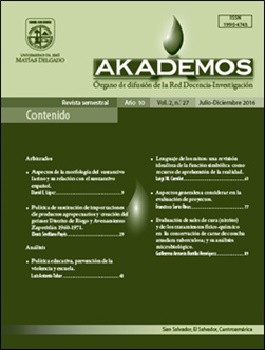Evaluation of curing salts (nitrite) and physical-chemical treatments in the conservation of shellfish Anadara tuberculosa; And its microbiological analysis
DOI:
https://doi.org/10.5377/akademos.v2i27.4434Keywords:
Sales of cure, heat treatment, microbiological tests, sensory analysis and preservingAbstract
During the investigation of the effect of using cure salts (200 ppm nitrite) and heat treatment at 70 for 3 minutes for 80 and 2 minutes was measured to determine the possibility of preserving the organoleptic properties and prolong life. The microbiological tests showed negative test results total plate count, coliforms, fecal coliforms as well as negative responses in pathogens: Escherichia coli, Salmonella typhi and Vibrio cholerae, indicating that the treated products pose no health hazard
Not so the samples that were not treated with any of the methods explained where his most probable number of bacteria was more than 1100 MPN / ml also a total bacteria count of 9.9 X10 4 CFU / ml Coliform bacteria 7.9X10 4 CFU / ml and fecal coliforms 2.9X10 4 CFU / ml (Enterobacter aerogenes) demonstrating that a sample “al fresco” shell represents a danger for the consumer
The sensory analysis determined that the null hypothesis was rejected because the F Observed is greater than the F Critical because this is in the rejection of a signifisignificance level of 5%. This demonstrates that treatments affect differently on the samples affecting its sensory properties.
AKADEMOS, Year 10, Vol. 2, No 27, July-December 2016: 89-101
Downloads
1346

